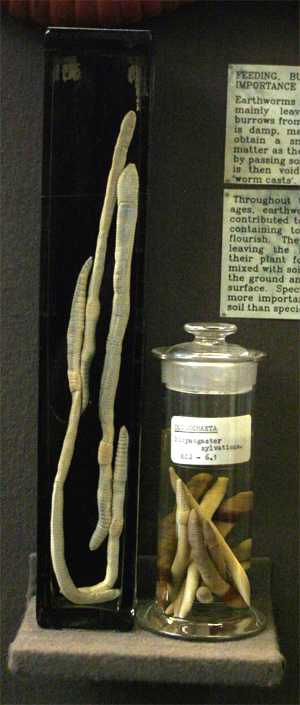
CLASS OLIGOCHAETA | |
These mainly terrestrial annelids (3100 species) have chaetae but no parapodia and no distinct head region. Susceptible to desiccation they can only survive on land in aquatic habitats or as earthworms burrowing in damp soil. They occur throughout the world except in deserts. Life on dry land places certain restrictions on animals with regard to reproduction. In the absence of a fluid environment, sperm has to be transferred directly from animal to animal and larvae are at risk from desiccation. Thus, unlike polychaetes, oligochaetes are hermaphroditic worms with internal fertilisation and complex reproductive organs which enable them to lay their eggs in protective cocoons. Aquatic oligochaetesAquatic oligochaetes, like Tubifex, live in the bottom sediment of freshwater habitats; some are amphibious and live in marshes and bogs. A few species occur in the intertidal zones of the sea living in sea-weeds, below rocks or as shallow burrowers. EarthwormsEarthworms can only survive by burrowing in damp soil. Earthworms feed on vegetable matter, mainly leaves dragged into their burrows from the surface when the air is damp, mainly at night. They also obtain a small amount of organic matter as they excavate their burrows by passing soil through their guts. This is then voided on the surface as worm casts. Throughout the world and over the ages earthworms have continuously contributed to the creation of humus containing top-soil in which plants flourish. They have done this by leaving the indigestible remains of their plant food as vegetable mould mixed with soil in the surface layers of the ground and as worm casts on the surface. Species of Allobophora are more important in the making of top-soil than species of Lumbricus. Earthworms usually pair above ground on warm, dark summer nights often with their tails tucked into their burrows in case danger threatens. They use their chaetae and a belt of mucus to hold them together while they exchange sperm, which is stored in the spermatheca. Eggs are fertilised as they pass the spermatheca on their way to be laid in a cocoon secreted by the glandular saddle or clitellum. Young earthworms look like their parents. |
 |
|
Some earthworms grow very large especially the large grumblers of Australia so called because of the noises they make as they burrow. Recently recognised as a threatened species, these large earthworms are now under the protection of the Australian Government. |
 |
Charles Darwin and earthwormsThe role of the earthworm as an animal of overwhelming economic importance was first recognised by Charles Darwin in his treatise ‘The Formation of Vegetable Mould through the Action of Worms’ published in London in 1888 some years prior to his best known work ‘The Origin of Species’. Darwin was briefly a student of medicine in this University (1825-1827) but did not really feel suited to this profession. His father ‘against my turning into an idle sporting man’ then sent him to Cambridge to study for the Church but nor was he destined to become a clergyman. On leaving Cambridge, he accepted the post of Naturalist on board H.M.S. Beagle, travelled round the world via the Galapagos and the rest is history. |






